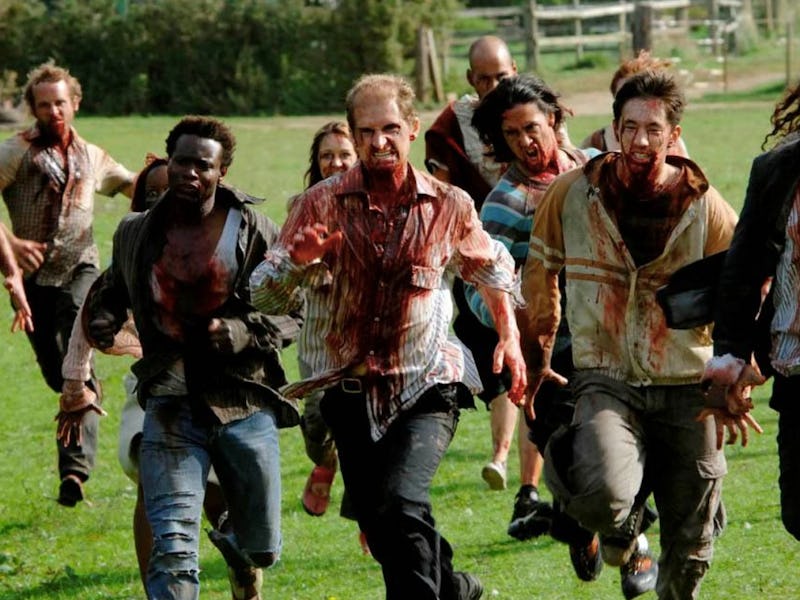How 28 Days Later predicted the chaos of a new millennium
The best zombie movie of the century has never been more relevant.

It may be hard to believe, but there was a time when the zombie as a trope was more dead than undead. After George A. Romero birthed our modern cultural understanding of the gruesome concept with Night of the Living Dead in the late ‘60s, he and other like-minded individuals continued to fine-tune flesh-eating throughout the ‘70s and ‘80s until the genre languished in disinterest during the ‘90s.
What had once represented ideas of societal ignorance and consumerist malaise had been slowly ignored as a new set of anxieties gripped the globe. Suddenly, biological warfare, international hyper-connectivity, and the burgeoning digital space were more prominent concerns. But zombies are notoriously hard to put down, and in 2002, they made an unforgettable comeback that reanimated public interest in the genre while also tapping into contemporary fears that would only grow in the coming years. Despite not even considering it a zombie film, Alex Garland and Danny Boyle brought the zombie into the new millennium with 28 Days Later.
28 Days Later is streaming now on HBO Max, but it’s leaving at the end of the month. Here’s why you need to watch (or rewatch it now) and what you should know before you do.
One of the many ways 28 Days Later shed the skin of its predecessors was by smashing audiences straight into ground zero of the outbreak, a decision with a bit of hilarious irony considering Alex Garland first began to formulate the script after playing Capcom’s classic Resident Evil. Both reinventions of the zombie formula are kicked off by moronic megacorporations dabbling in sciences they can’t hope to control, and the presence of the well-meaning but situationally-ignorant animal rights activists at the beginning of the movie was deeply relevant in 2002. The ‘90s were defined by a wave of wins for animal rights, including General Motors ending the practice of using animals in crash tests, a parallel that somewhat mirrors the infected test monkeys at the beginning of 28 Days Later. Despite their noble intentions, the activists accidentally unleash one of the most terrifying outbreaks to infect pop culture.
Garland’s “Rage” virus separated itself from any other zombie contagion up until that point by spreading rapidly amongst living subjects, broadening the capacity for infection and making it that much more terrifying. Released only a year after the mysterious anthrax attacks that rocked America back in 2001, the threat of biological weaponry was in the collective conscience, and the haze of uncertainty after 9/11 contributed to a growing paranoid fear of the interconnectivity of the world at large. The way Boyle’s direction frames the hordes of Rage-infected Brits as insurmountable and unrelenting is even more terrifying when multiplied against the population of the entire world. At the same time, an entirely new frontier of connection was opening up that was exposing a wall of chaos all its own.
Cillian Murphy in 28 Days Later.
Back in 2002, there was no way to predict the ubiquity of how involved the internet would be in our daily lives, but the havoc wrought by the Rage virus resembles the wall of noise that is social media. Both brutal and overwhelming, watching the infected swarm and maul their victims evokes the swift vitriolic mob of a Twitter dog pile or a coordinated KiwiFarms attack. The interconnectivity of the internet means its grasp can reach out and touch anyone, and sometimes the effect is not unlike listening to the synchronous footsteps and ravenous sounds of the approaching horde.
But there’s another mood that underlies the chaos of 28 Days Later, and it’s one of profound loneliness. From the moment our main character Jim (Cillian Murphy) wakes up from his coma almost a month into the outbreak, Boyle’s direction conveys the emptiness and isolation felt from Jim’s slow realization that he might be the only man left alive in London. The gritty, scarred cinematography feels like watching an old abandoned film reel in the far-flung future. John Murphy’s score feels discordant and spacey in a deeply affecting way. Even his use of the song “East Hastings” by Godspeed You! Black Emperor evokes a deep emptiness of the soul that can only be filled by a higher power.
Brendan Gleeson and Megan Burns with Murphy.
Even as the movie introduces other survivors to accompany Jim, such as father/daughter duo Frank (Brendan Gleeson) and Hannah (Megan Burns); as well as the hardened survivalist Selena (played by a brilliantly abrasive Naomie Harris), there’s always the prevalent terror that at any moment these companions could be torn away. In an age where the internet promises to connect us more than ever, studies have long shown that extended exposure to the vastness of the internet can lead to depressive symptoms.
Like many of its predecessors, 28 Days Later uses the physical horror of bloodthirsty ghouls as a launchpad to reach for loftier anxieties, but it never quite loses sight of the pulpiness of its inspirations. Boyle and Garland work hard to craft a genuinely scary and exciting thrill ride. The pitch-perfect combination of desolate atmosphere, somber directing, and creeping dread not only reinvigorated a genre and jump-started a franchise, but it has also captivated audiences since its release two decades ago.
28 Days Later leaves HBO Max on October 31.
This article was originally published on